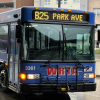Boston Mayor Marty Walsh has a plan to make the city more resilient to sea level rise and storm flooding. Walsh previewed his strategy at a press conference with reporters Tuesday. He said the city needs to act to prevent rising sea levels that will cause billions of dollars in damage to the city.
"I'm not sure if any other city in America has quite planned this way,” he said. “They have after the fact. New Orleans had to plan after Katrina. But we want to get ahead of this game and plan before before something happens like that."
Chris Cook, the city's chief of environment, energy and open space, said that flood projection maps show much of South Boston, the South End and Dorchester will be under water that flows in from two directions.
"In 2070, if we do nothing, the inundation on a regular basis from Moakley Park can actually meet the inundation at Fort Point Channel and flood the neighborhoods backwards,” Cook said. “In addition, there's an extra layer of vulnerability at Fort Point channel, where the water can actually flood into the Mass Pike and actually flood the South End and the Back Bay."
To prevent that, Walsh plans to build up parks and other barriers along Boston's 47-mile shoreline, to serve as a buffer against storm surges.
"Some of this buffer will be a seawall,” he said. “Some of this buffer will be elevated park space. Some of this buffer will be elevated seawall; some of this buffer will be removable seawall. Some of this buffer will be a park down to Fort Point Channel. Some of this buffer will be elevating Moakley Park."
Building up Moakley Park, the mayor said, could protect thousands of residents in three South Boston public housing complexes. Walsh said more must be done in Dorchester, too.
"Elevating Morrissey Boulevard, elevating Victory Park, elevating the Neponset trail — literally it will act as a buffer and save tens of thousands of homeowners,” Walsh said.
The plan does not include a harbor-wide barrier, which was studied by UMass Boston and ruled to be ineffective and hugely expensive. It does call for adding landfill to the harbor in some places and creating new coastline to prevent flooding.
In all, 67 acres of new open space would be created, and the Emerald Necklace park system would be extended to the waterfront.
It's not clear yet how much this will all cost, Walsh said, since the plans will evolve with community input and the costs will go up over the many years all of this will take. But Walsh said paying for it now means saving money later.
"Whether it's East Boston, I think it's $160 million investment saves us $450 million — something to that effect. South Boston, a billion-dollar investment now saves us $19 billion in devastation damage, potentially estimated,” he said.
The city is committed to making that kind of investment, he said.
"Moving forward, 10 percent of all of our capital money that we spend will have to go towards resiliency projects," Walsh said.
For now, that shouldn't result in higher taxes. Walsh hopes to get support from the state, as well as nonprofits and philanthropies. The city is applying for a $10 million FEMA grant right now. But Walsh said he's not expecting much help from Washington.
"They've informed us all that climate change is a fake made up thing and it's not real,” he said. “So, until we have somebody in that corner office that acknowledges the fact that this is real, I don't know how much money would be coming from the federal government."
The city also will look for assistance from the private sector, most notably at a Wednesday Boston Chamber of Commerce breakfast. Walsh said that building up buffers along the waterfront is going to be complicated, because the city's Harborwalk touches hundreds of properties. But, he said, he expects the city's waterfront businesses and landowners to support this.
"They come to our city for a reason, and they want to be successful here and they also have a vested interest in wanting to make sure that that that they are protected in the case of a super storm," Walsh said.





